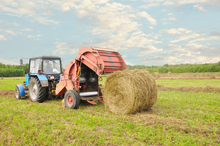Hay is the basis for your horse’s health. Just as a human diet that lacks proper nutrition results in poor health, so too does substandard hay, so it pays to do a little research to learn what you’re buying to feed your horses.

Avoiding contaminated hay
Just as a human diet lacking proper nutrition results in poor health, so does substandard hay when fed to horses; therefore it pays to do some research to make sure hay has the highest nutritional value possible.
Horse owners should be asking sellers about the hay’s nutrient content. Higher protein is desirable, but there is a limit. Alfalfa, for example, is an excellent source of protein and energy. Adult horses require 10-11 percent crude protein in their overall diet while growing horses require 12-14 percent.
Pure alfalfa hay can have protein levels exceeding 18 percent. This high level of protein is not required for most horses, which is one reason many growers mix high-protein alfalfa with lower-protein grasses such as timothy.
Another problem in hay selection is weed content. Even premium hay may contain weeds. “Certified weed-free hay” doesn’t mean there are no weeds, only that the weeds haven’t gone to seed, notes Steve Fransen, forage crops specialist at the Washington State University extension office in Prosser. While managed hay fields are typically reliable, even the best pasture management can’t eliminate all weeds from infesting a crop. This is especially true around the pasture margins, where weeds tend to creep into the field.
Although foxtail isn't toxic to horses, it contains sharp bristled clusters that may work their way under horses’ gums. Horses have developed ulcers and gingivitis from hay that contained large amounts of foxtail.
The infections can take many months and veterinary treatments to cure. A veterinarian has to scrape the organic matter from under the horses’ inflamed gums. Medications are usually required until the infections clear.
Veterinarian Richard Vetter of Performance Equine Dentistry, Buckley, Wash., said he’s seen cases where veterinarians misdiagnosed gum-related problems. Vigilance and awareness by the owner may alert a vet to the possibility of weed-related infections, especially if it’s noted that hay contains nuisance weeds.
Vetter notes that infection can vary within a barn. What bothers one horse may not affect others, said Vetter. He’s seen situations where there have been two horses side by side, one with ulcers and the other without mouth problems.
The weed commonly known as “houndstongue” often grows along ditch banks and fence rows, and also grows out into some hayfields and may be harvested with the hay. The toxin contained is a pyrrolizidine alkaloid that causes liver damage and prevents generation of new liver cells. Both cattle and horses have been killed with hay contaminated by houndstongue.
It pays to know how to identify nuisance weeds such as foxtail that may injure your horse’s gums or otherwise contribute to health issues. If you don’t know what weeds are in your hay, you can take a sample bale to your local Conservation District office or agricultural extension office for inspection.
Forages contaminated with weeds are reduced in quality, nutritive value and palatability but may also be toxic. For these reasons, careful selection of hay is important to the health of your horse.
Read more about Feed for Your Horse
